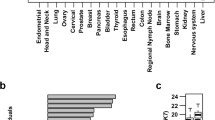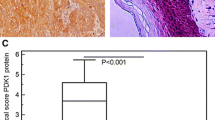Abstract
Protein Tyrosine Phosphatase Receptor J (PTPRJ) has been reported to be a tumor suppressor in various human cancers. The aim of this study was to investigate the clinical significance of PTPRJ in ESCC patients and its effects on biological behaviors of ESCC cells. PTPRJ expression, at mRNA and protein levels, were respectively detected by quantitative real-time PCR, western blot and immunohistochemistry, based on 106 newly diagnosed ESCC patients. The associations between PTPRJ expression and clinicopathological characteristics of ESCC patients were statistically analyzed. Then, the effects of PTPRJ in migration and invasion were determined by wound healing and transwell assays based on ESCC cell line transfected with siRNA or expression vector of PTPRJ. Expression of PTPRJ at mRNA and protein levels were both significantly lower in ESCC tissues than those in normal esophageal mucosa. Immunohistochemistry showed that PTPRJ protein was localized in the cytoplasm of cancer cells in ESCC tissues. In addition, PTPRJ downregulation was found to be closely correlated with advanced tumor stage (P = 0.01) and poor differentiation (P = 0.03). Moreover, knockdown of PTPRJ in KYSE510 cells could significantly promote cell migration and invasion (both P < 0.05), which were reversed by the restoration of PTPRJ expression in vitro (both P < 0.05). Our data offer the convincing evidence that loss of PTPRJ expression may predict an aggressive clinical course in ESCC patients. PTPRJ may function as a tumor suppressor and play an important role in the regulation of ESCC cell motility, suggesting its potentials as a therapeutic agent for human ESCC.



Similar content being viewed by others
References
Baba Y, Watanabe M, Yoshida N, Baba H (2014) Neoadjuvant treatment for esophageal squamous cell carcinoma. World J Gastrointest Oncol 6:121–128
Shang L, Wang M (2013) Molecular alterations and clinical relevance in esophageal squamous cell carcinoma. Front Med 7:401–410
Li JS, Ying JM, Wang XW, Wang ZH, Tao Q, Li LL (2013) Promoter methylation of tumor suppressor genes in esophageal squamous cell carcinoma. Chin J Cancer 32:3–11
Krüger J, Brachs S, Trappiel M, Kintscher U, Meyborg H, Wellnhofer E, Thöne-Reineke C, Stawowy P, Östman A, Birkenfeld AL, Böhmer FD, Kappert K (2015) Enhanced insulin signaling in density-enhanced phosphatase-1 (DEP-1) knockout mice. Mol Metab 4:325–336
Petermann A, Stampnik Y, Cui Y, Morrison H, Pachow D, Kliese N, Mawrin C, Böhmer FD (2015) Deficiency of the protein-tyrosine phosphatase DEP-1/PTPRJ promotes matrix metalloproteinase-9 expression in meningioma cells. J Neuro-Oncol 122:451–459
Spring K, Lapointe L, Caron C, Langlois S, Royal I (2014) Phosphorylation of DEP-1/PTPRJ on threonine 1318 regulates Src activation and endothelial cell permeability induced by vascular endothelial growth factor. Cell Signal 26:1283–1293
Ortuso F, Paduano F, Carotenuto A, Gomez-Monterrey I, Bilotta A, Gaudio E, Sala M, Artese A, Vernieri E, Dattilo V, Iuliano R, Brancaccio D, Bertamino A, Musella S, Alcaro S, Grieco P, Perrotti N, Croce CM, Novellino E, Fusco A, Campiglia P, Trapasso F (2013) Discovery of PTPRJ agonist peptides that effectively inhibit in vitro cancer cell proliferation and tube formation. ACS Chem Biol 8:1497–1506
Smart CE, Askarian Amiri ME, Wronski A, Dinger ME, Crawford J, Ovchinnikov DA, Vargas AC, Reid L, Simpson PT, Song S, Wiesner C, French JD, Dave RK, da Silva L, Purdon A, Andrew M, Mattick JS, Lakhani SR, Brown MA, Kellie S (2012) Expression and function of the protein tyrosine phosphatase receptor J (PTPRJ) in normal mammary epithelial cells and breast tumors. PLoS One 7:e40742
Spring K, Fournier P, Lapointe L, Chabot C, Roussy J, Pommey S, Stagg J, Royal I (2015) The protein tyrosine phosphatase DEP-1/PTPRJ promotes breast cancer cell invasion and metastasis. Oncogene In press
Yan CM, Zhao YL, Cai HY, Miao GY, Ma W (2015) Blockage of PTPRJ promotes cell growth and resistance to 5-FU through activation of JAK1/STAT3 in the cervical carcinoma cell line C33A. Oncol Rep 33:1737–1744
Chen G, Peng J, Zhu W, Tao G, Song Y, Zhou X, Wang W (2014) Combined downregulation of microRNA-133a and microRNA-133b predicts chemosensitivity of patients with esophageal squamous cell carcinoma undergoing paclitaxel-based chemotherapy. Med Oncol 31:263
Ferlay J, Shin HR, Bray F, Forman D, Mathers C, Parkin DM (2010) Estimates of worldwide burden of cancer in 2008. Int J Cancer 127:2893–2917
Xu X, Lan W, Jin X, Wang B, Yan H, Chen X, Lai X, Zhang L, Zhang X, Li Z (2014) Regulated expression of PTPRJ by COX-2/PGE2 axis in endothelial cells. PLoS One 9:e114996
Dave RK, Dinger ME, Andrew M, Askarian-Amiri M, Hume DA, Kellie S (2013) Regulated expression of PTPRJ/CD148 and an antisense long noncoding RNA in macrophages by proinflammatory stimuli. PLoS One 8:e68306
Aya-Bonilla C, Green MR, Camilleri E, Benton M, Keane C, Marlton P, Lea R, Gandhi MK, Griffiths LR (2013) High-resolution loss of heterozygosity screening implicates PTPRJ as a potential tumor suppressor gene that affects susceptibility to Non-Hodgkin’s lymphoma. Genes Chromosom Cancer 52:467–479
Liotta LA, Kohn EC (2001) The microenvironment of the tumour-host interface. Nature 411:375–379
Wang W, Goswami S, Sahai E (2005) Tumor cells caught in the act of invading: their strategy for enhanced cell motility. Trends Cell Biol 15:138–145
Ridley AJ, Schwartz MA, Burridge K (2003) Cell migration: integrating signals from front to back. Science 302:1704–1709
Author information
Authors and Affiliations
Corresponding authors
Ethics declarations
Conflict of Interest
None.
Additional information
Dongfeng Qiao and Ming Li contributed equally in this study.
Rights and permissions
About this article
Cite this article
Qiao, D., Li, M., Pu, J. et al. Loss of Protein Tyrosine Phosphatase Receptor J Expression Predicts an Aggressive Clinical Course in Patients with Esophageal Squamous Cell Carcinoma. Pathol. Oncol. Res. 22, 541–547 (2016). https://doi.org/10.1007/s12253-015-0036-3
Received:
Accepted:
Published:
Issue Date:
DOI: https://doi.org/10.1007/s12253-015-0036-3




